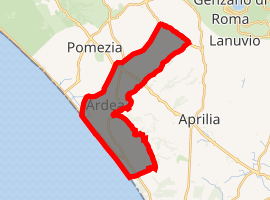Ardea, Lazio
Ardea (IPA: [ˈardea], less correctly [arˈdɛːa]) is an ancient town and comune in the Metropolitan City of Rome, 35 kilometres (22 miles) south of Rome and about 4 kilometres (2 miles) from today's Mediterranean coast.
Ardea | |
|---|---|
| Comune di Ardea | |
The church of St. Peter. | |
Location of Ardea 
| |
 Ardea Location of Ardea in Italy  Ardea Ardea (Lazio) | |
| Coordinates: 41°37′N 12°33′E | |
| Country | Italy |
| Region | Lazio |
| Metropolitan city | Rome (RM) |
| Frazioni | Banditella, Nuova Florida, Castagnetta, Castagnola, Centro Regina, Nuova California, Colle Romito, Lido dei Pini, Marina di Ardea, Rio Verde, Tor San Lorenzo, Tor San Lorenzo Lido, Montagnano. |
| Government | |
| • Mayor | Mario Savarese (Movimento 5 Stelle) |
| Area | |
| • Total | 50 km2 (20 sq mi) |
| Elevation | 37 m (121 ft) |
| Population (31 December 2017)[2] | |
| • Total | 49,663 |
| • Density | 990/km2 (2,600/sq mi) |
| Demonym(s) | Ardeatini |
| Time zone | UTC+1 (CET) |
| • Summer (DST) | UTC+2 (CEST) |
| Postal code | 00040 |
| Dialing code | 06 |
| Patron saint | St. Peter the Apostle |
| Saint day | June 29 |
| Website | Official website |
The economy is mostly based on agriculture, although, starting from the 1970s, industry has played an increasingly important role.
History
Ardea is one of the most ancient towns in western Europe, founded during the 8th century BC. According to tradition it was the capital of the Rutuli, and it is described as such in the Aeneid.
In 509 BC Lucius Tarquinius Superbus, the king of Rome sought unsuccessfully to take the town by storm, and then commenced a siege of the town.[3] However the siege was interrupted by the revolution which resulted in the overthrow of the king and the establishment of the Roman republic. One of the leaders of the revolution, Lucius Junius Brutus, came to the camp of the Roman army at Ardea and won the army's support for the revolution.
In 443 BC the Volscians laid siege to Ardea. The siege was soon broken by Roman troops under the leadership of Marcus Geganius Macerinus.
After the Roman conquest, Ardea was most often mentioned in connection with the Via Ardeatina, one of the consular roads, to which it gave its name.
During the Second Punic War, it was one of the few cities that refused military support to Rome, and, after the Roman victory, was deprived of its autonomy. In the 3rd-2nd centuries BC it decayed until, in the Imperial Age, it was scarcely populated at all. The 1st century agricultural writer Columella possessed estates there.[4]
After the fall of the Western Roman Empire, Ardea was abandoned. It returned to grow only after the 9th century AD. Its castle in 1118 housed Pope Gelasius II and was later contended among various feudal barons of the area. In 1419 Pope Martin V assigned it to his kinsmen, the Colonna family, who sold it in 1564 to the Cesarini.
In 1816 it became a frazione of Genzano. Starting from 1932, the surrounding area was drained and Ardea began to flourish again, becoming a frazione of Pomezia starting from its foundation around 1948 and an independent municipality in 1970.
Main sights
Remains of the ancient city include the old defensive agger, dating to the 7th century BC and later (4th century BC) updated to larger walls. Archaeological excavations have brought to light four temples, of unknown dedication. Part of the pavement of a basilica (c. 100 BC) have also been found in the area of the ancient Forum. Other sights include:
- The Church of Santa Marina, erected in 1191 by Cencio Savelli, the future Pope Honorius III. The interior, on a single nave, was originally entirely frescoed.
- Romanesque Church of San Pietro Apostolo (12th century), which was a possession of the monks of San Paolo Fuori le Mura of Rome. It incorporates a former watchtower used to counter Saracen attacks, now turned into a bell tower. It has 15th-century frescoes and a 16th-century wooden crucifix.
- The Giardini della Landriana,[5] designed by Russell Page.
- Giacomo Manzù[6] Museum, housing some 400 works of the artist.
- Tor San Lorenzo, a tower in the eponymous seaside frazione. It was rebuilt in 1570 after a design by Michelangelo, in the area of a former Palaeo-Christian church devoted to St. Lawrence.
International relations
Ardea is twinned with:
References
- "Superficie di Comuni Province e Regioni italiane al 9 ottobre 2011". Istat. Retrieved 16 March 2019.
- "Popolazione Residente al 1° Gennaio 2018". Istat. Retrieved 16 March 2019.
- "Lucius Tarquinius Superbus". Unrv.com. 2007-02-01. Retrieved 2013-03-25.
- Lucius Junius Moderatus Columella (1745). L. Junius Moderatus Columella of Husbandry, in Twelve Books: and his book, concerning Trees. Translated into English, with illustrations from Pliny, Cato, Varro, Palladius and other ancient and modern authors. London: A. Millar. p. 130.
- il michele. "Stefanina Aldobrandini Ricevimenti". Aldobrandini.it. Retrieved 2013-03-25.
- "Home - Raccolta Manzù". Museomanzu.beniculturali.it. Archived from the original on 2013-03-06. Retrieved 2013-03-25.
- "Italy - Lazio: Towns Twinning". En.comuni-italiani.it. 1998-04-26. Retrieved 2013-03-25.
Sources
- Livy, Ab urbe condita 4.9
External links
| Wikimedia Commons has media related to Ardea (Italy). |
- Official website
- Quilici, L.; S. Quilici Gigli; R. Talbert; T. Elliott; S. Gillies. "Places: 422843 (Ardea)". Pleiades. Retrieved March 8, 2012.